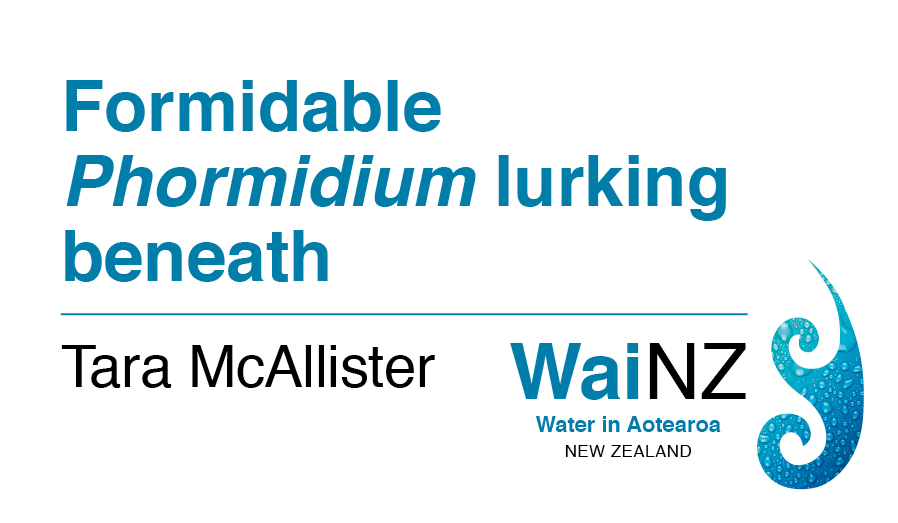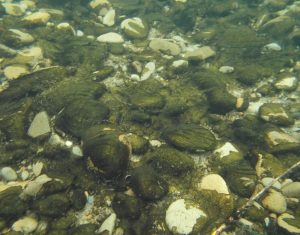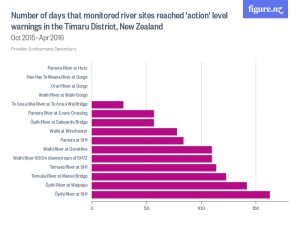One of my favourite rivers in the Canterbury region is the Ōpihi River. Its mauri, however, has been eroded and like many of our rivers, it is now a shadow of its former self. Currently, one of the many problems in this catchment is toxic algal blooms. These blooms are formed by Phormidium, which is a type of cyanobacteria (looks like algae but are actually bacteria), that starts off as a tiny microscopic filament and then forms dense, carpet-like mats on the river bed.
Under certain environmental conditions, Phormidium can grow extremely quickly forming black mats that cover the entire river bed. Low and stable flows appear to be a recipe for Phormidium success, however a diverse range of other factors including sediment and nutrients likely to contribute to its success. To complicate matters, the relative importance of each of these factors varies from river to river.
Phormidium can produce powerful toxins which pose a significant threat to human and animal health and the integrity of our freshwater ecosystems. Just one teaspoon of toxic Phormidium can kill a 25 kg dog very quickly. Since the first documented dog death in 1998, over 100 dogs have died in Aotearoa from ingesting Phormidium mats.
While we do not yet fully understand the ramifications of Phormidium blooms for the river itself, we do observe shifts in macroinvertebrate communities and anglers report that trout caught in waters containing Phormidium can taste earthy and smell musty.

The Ōpihi River from above. The road in the middle is State Highway 1 and the darked sections of the river are Phormidium blooms.
Every summer, many New Zealanders are unable to access what I believe is a birth right and swim in their local rivers, due to excessive Phormidium growth. For example, of the 15 sites in the Timaru District that were monitored for cyanobacteria, eleven sites had excessive Phormidium growth between October 2015 and April 2016. Phormidium blooms in the Ōpihi River were particularly bad, with a warning at the State Highway One site in place for over 150 days (17 November 2015 to 28 April 2016).
This issue is not only restricted to the Canterbury region, where there is a high proportion of agricultural land-use, but these blooms occur all throughout Aotearoa and even throughout the world. A recent survey identified 103 rivers in New Zealand had experienced one or more Phormidium blooms between 2009 and 2016. This data only represents the portion of rivers which are monitored, so it is likely that many other unmonitored rivers are also affected by Phormidium.

Rivers in Aotearoa where one or more sites have experienced a Phormidium bloom (which is >20% benthic cover) on at least one occasion between 2009 and 2016.
Since the 19th century, there have been numerous changes to our rivers, which have pushed many beyond their breaking point and as a result we can no longer swim in them, let alone eat kai harvested from them.
I believe that the increasing severity and extent of Phormidium blooms in New Zealand rivers are a symptom of land-use change and the culmination of many alterations to these systems including changes to flow regimes (through water abstraction) and increased sediment, nutrients and water temperatures. All of these changes have made many of our rivers the ideal breeding ground for toxic algae.
Tara McAllister
Useful links
To find out more about Phormidium, here is a review article: http://www.sciencedirect.com/science/article/pii/S1568988316300476 or email tara.mcallister0@gmail.com for a copy.
You can also follow this link https://vimeo.com/160826825 to hear Dr Susie Wood from the Cawthron Institute (Nelson), a world leader in cyanobacterial research, speak about Phormidium.
About:
Tara McAllister is a PhD candidate in the Waterways Centre for Freshwater Management at the University of Canterbury, and is currently investigating the environmental drivers of Phormidium blooms in New Zealand rivers. She also works part-time at Mahaanui Kurataiao Ltd, which is an environmental advisory company established by six Rūnanga in Christchurch.
What is WaiNZ?
Kia ora, Aotearoa. We’ve asked leading environmental, social and health researchers to share their personal and professional perspectives about the state of our water and what water means to us as New Zealanders. Follow their blogs right here at tepunhahamatatini.ac.nz and across social media with #WaiNZ.
Where possible, commentary will be backed up by data from Figure.NZ. Their incredible charts are based on data sourced from public repositories, government departments, academics and corporations. Check out their #WaiNZ data board and sign-up to create your very own data board on any topic that interests you.



